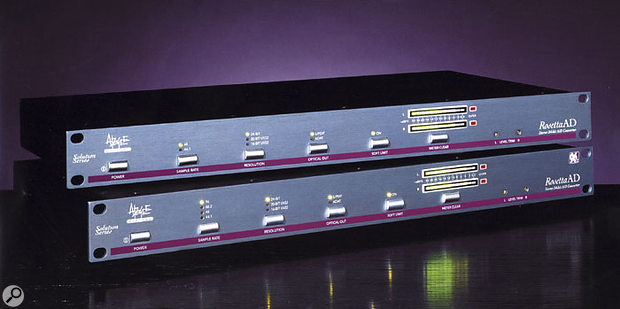Lately, there seem to be numerous affordable hardware compressors on the market, and I've noticed that many of them (the Platinum Focusrites and the Joemeeks, for example) are described as optical compressors. What's the difference between optical compressors and other types of compressor, such as VCA, FET and valve compressors? Are there any relative merits to these different types of compressor and are they suited to any particular applications?
Luke Ritchie
Editor In Chief Paul White replies: After microphones, nothing stirs up a group of music professionals so much as a discussion about compressors. Essentially, compressors are gain-riding devices that monitor the level of the incoming signal and then apply gain reduction in accordance with the user's control settings. Given this simplistic explanation, shouldn't all compressors sound exactly the same, in the same way that faders tend to?
Clearly compressors don't all sound the same, and there are a few good technical reasons why. Perhaps of less importance than some people might imagine is the gain control element itself, which can be a tube, a FET (field effect transistor), a VCA (voltage-controlled amplifier), an optical photocell arrangement (a light source and a light detector) or even a digital processor. Certainly all these devices add their own colorations and distortions to a greater or lesser extent, but what influences the sound most is the way the ratio and envelope characteristics deviate from theoretically perfect behaviour.
In an imaginary, perfect compressor, nothing happens to the signal until it reaches a threshold set by the user, after which a fixed compression ratio is applied. For example, if the compression ratio is set at 4:1, for every 4dB the signal rises above the threshold, the output rises by only 1dB. A modification to this is the soft-knee compressor where the ratio increases progressively as the signal approaches the threshold, the end result being a less assertive, less obtrusive form of compression.
Many classic designs don't in practice act like this perfect compressor however, as their compression ratio may vary with the input signal level. For example, some compressors work like a perfect soft-knee device until the signal has risen some way above the threshold, then the compression ratio reduces so that those higher level signals are compressed to a lesser degree than signals just above the threshold.
The reason for this change in ratio is simply that many early gain-reduction circuits don't behave linearly, especially those using optical circuitry as the variable gain element. The components themselves are non-linear so when, for example, you combine a non-linear light source with a non-linear light detector, the composite behaviour can be quite complex and unpredictable — however, history has buried those optical circuits that didn't sound good, so we're now left with those that happened to sound musical.
The other very important factor governing the sound of a compressor is the shape of the attack and release curves. While a modern VCA compressor can be made to behave in an almost theoretically perfect way with a constant ratio and predictable attack/release curves, many of the older designs had very strange attack and release characteristics, and, in the case of optical compressors, this was originally due to the relatively slow response of a light and photocell compared with a VCA.
For example, the now legendary Universal Audio 1176 combined a fairly fast attack time with a multi-stage release envelope. Conversely, the Teletronix's LA2A's rather primitive optical components resulted in a slower and quite non-linear attack combined with a release characteristic that slowed as the release progressed. Indeed, perhaps the reason the traditional opto compressor has so much character is that there are so many places in the circuitry that non-linearities can creep in.
Having said that, some modern optical compressors use specialised integrated circuits that incorporate the necessary LED light source (which has largely taken over from the filament lamps and electroluminescent devices used in early designs) and detector element in a single package that incorporates feedback circuitry to speed up the response time and to linearise the gain control performance. Indeed, some of these are so well behaved that they can sound almost like VCAs, but using clever design, it should be possible to recreate the old sounds as well as the new using contemporary electronic devices, or imaginative software design come to that.
It's harder when it comes to saying what type of compressor is best for which job, but in very general terms, a well-designed VCA compressor will provide the most transparent gain reduction, which is ideal for controlling levels without changing the character too much. However, a compressor that allows high-level transients to sneak through with less compression can also sound kinder to material than one that controls transients too assertively, which is why some of the older, less linear designs sound good.
That's not to say modern designs can't sound good too though — Drawmer pioneered the trick of leaking high frequencies past the compressor to maintain transient clarity while other manufacturers, such as Behringer, use built-in transient enhancers or resort to equally ingenious design tricks.
Optical compressors, especially those that don't use super-well-behaved integrated optical circuits (or those that use them imaginatively) usually impose more of their own character on the material being treated, making it sound larger than life. In this context, the compressor is as much an effect as a gain-control device, and such compressors are popular for treating vocals, drums and basses. The Joemeek and TFPro compressors fit this 'compression as an effect' category as they use discrete LEDs and photocells in a deliberately non-linear topography that's really a refinement of that used in some vintage designs.
Digital compressors and plug-ins can reproduce the characteristics of vintage classics, but only if the designers successfully identify those technical aspects of the original design that make it sound unique. If they don't, you end up with an approximation or caricature rather than a true emulation.













